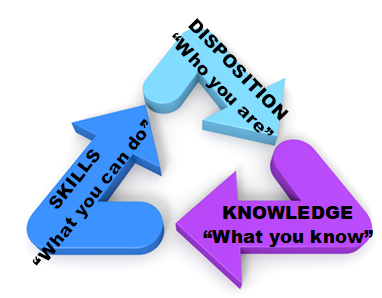
Skills of History
The study of history helps us develop a set of skills that can be applied in countless contexts. This webpage is a resource for our students of how historians define what it is that historians do. To think as a historian requires a learned, systematic approach. There is no consensus as to what represents the top five or ten or twenty skills, but a practicing historian needs to develop their own. Below are several examples, including other useful online links.
Example #1: Bruce Lesh

Example #2: Thomas Andrew and Flannery Burke
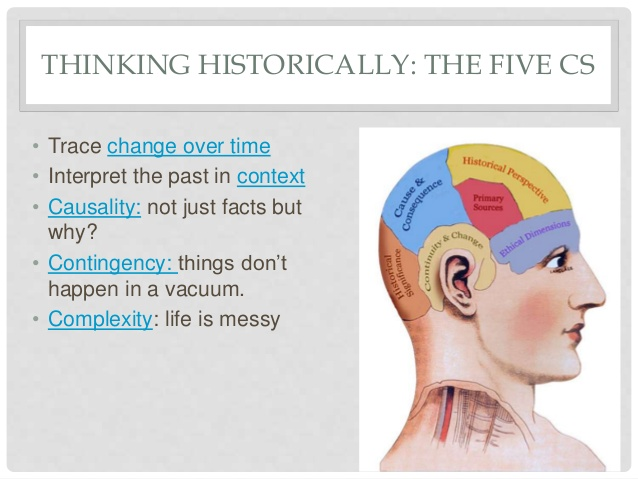
Example #3: Tim Lacy
The Twelve “C’s” of Historical Thinking
Many moons ago, in 2013, I expanded on Thomas Andrew’s and Flannery Burke’s excellent work on “The 5 Cs of Historical Thinking” (2007). I lengthened the list to nine. Since then, with student feedback, I’ve revised the list and added a few more points. Below is my latest version. This is my last addition. Anything beyond a dozen exceeds mnemonic capacity. But I reserve the right to fiddle with my descriptions of existing entries. PS: If you’d like the document in MS Word form, say the word.
Note: The first five points that follow derive from Andrews’ and Burke’s “5 Cs” (Perspectives in History, 2007), but are reworded and reworked here in my own terms. They correlate strongly with what Jenkins’ calls “heartlands” concepts in history (p. 16-17). The rest are mine.
Change Over Time: Historians see change over time in terms of growth, decay, and continuity. This is the easiest to grasp of all the ‘Cs’ listed here. But one must also consider the rate of change, as well as the feeling of change—both in relation to past actors and in relation to present readers. This means historians select and emphasize evidence to highlight some changes at the expense of others.
Context: Historians interpret the past in context, but also actively create context for others. They interpret materials from the perspective of the world in which documents (words, pictures, sounds, etc.) were created. They avoid the fallacy of too much presentism (i.e. seeing the past in terms of the present); they would rather hover on the fringes of the fallacy of historicism (i.e. seeing the past as if it were unique, on its own terms). Context is a way of situating—of putting and imagining historical events and people in their own time. Contextualizing is about creating a web of connections in the past. This theme helps fight the parochialism of the present.
Causality: Historians are interested in causality—looking to understand why an event occurred. They always look for multiple causes, even when one appears dominant. Historians assess and weigh causes against each other in research. The identification of causal factors helps historians in selection and emphases in relation to evidence. For some people, the search for deep causes give history its meaning.
Contingency: Historians are concerned, at times, with what might have happened—with aleatory events (luck, etc.). This involves using one’s imagination in relation to potential causes and effects. From Andrews and Burke: “To argue that history is contingent is to claim that every historical outcome depends upon a number of prior conditions; that each of these prior conditions depends, in turn, upon still other conditions; and so on.” Things were not foreordained to happen as they did. They add: “To assert that the past is contingent is to impress upon students the notion that the future is up for grabs, and that they bear some responsibility for shaping the course of future history.” I see it this way: Asking questions involving contingency sometimes assures the historical thinker that her/his argument of causality is a good one.
Complexity: “The past is a foreign country,” said David Lowenthal, and historians actively cause others to appreciate the complexity of the past. History is messy, complicated, and not easily summarized—though it’s the job of historians to distill evidence and make some sense, or meaning, of history’s complexity. There is a paradox at work: history is not so complex as to be unexplainable, yet it also lives on its own terms. Assessing complexity involves rigor. Andrews and Burke assert that seeing complexity helps present-day thinkers avoid nostalgia, myth-making, and other traps of historical thinking. The greater complexity evident in story may increase the story’s plausibility.
Competition: The notion of competing narratives is essential to historical thinking. It is especially related to complexity and conjecture. Narratives compete for our attention most obviously in politics and in family memories. But the principle is also at work in reading and constructing histories generally. A “winning” narrative usually displays the best integrated and plausible storytelling, for people are fond of comprehensiveness in their histories (even while generalists understand the importance of narrowed and specialized historical inquiry). That said, no one story can ever integrate everything. And changing one or two elements (citations/sources) can change the perception and slant of a historical narrative. As such, a good historical thinker always knows that other legitimate, compelling narratives exist.
Chronology: Periodization is fundamental to narrative construction. Marking time matters because it provides fundamental, accessible sign posts for readers. Chronology differs from change because it is more nuts and bolts—about the preparation for evaluations of change and causation. Cataloguing events in relation to dates is necessary baseline work. It’s about ordering and the sense of order. The greater the sense of order, the greater the chance the story feels plausible to a reader. One needs to imagine or see some kind of order before changing or reassessing it. This point goes toward the ‘selection’ half of the old maxim about “selection and emphasis” mattering the most to historians.
Citations: Historians care about evidence, and use it carefully. They take detailed notes in relation to the evidence offered in one’s story. They are concerned with the authenticity of sources, whether archival and primary, or secondary. A foundation in good sources dictates the reliability and trustworthiness of one’s story. Pomeranz notes that the act of juxtaposing resources helps demonstrate a historian’s critical thinking skills, since compare-and-contrast is a fundamental characteristic of thoughtfulness. Thinking about citations also involves thinking about past narrative histories (i.e. historiography, or secondary sources). As with chronology, citations also involves selection—i.e. the legitimacy of one’s narrative and arguments. Citations help others understand how history is a social science.
Conjecture: Historians make a case for meaning by arguing points in theses. Those theses, greater (or overall) and lesser, use evidence selected and arranged. This conjecture can be tentative (i.e. hypothesis), or tested and reliable (i.e. thesis). This underscores the ‘emphasis’ half of the “selection and emphasis” maxim. In any case, the argument must be and feel plausible.
Characters: Historians often emphasize the persons and the humanity within their groupings. Per Pomeranz, historians work at “the construction of the actors in our histories.” This may involve representative anecdotes or, in some cases, more intense historical biographic portraits. The characters we ponder in the context of historical thinking remind others that history has a strong foothold in the humanities.
Continuity: Many people, but especially traditionalists and conservatives, look to history for indications of continuity. Historians emphasize change over time as a bread-and-butter aspect of historical thinking, but major human endeavors (e.g. philosophy, law, and religion) ponder essential aspects of human life. And perhaps some changes are so minimal that the appearance of continuity is important. This entry acknowledges both the search for continuity as well as the chance that some changes are minimal. The idea of ‘tradition’ is subsumed in continuity, though judgments about traditions vary (e.g. to be celebrated, to be approached skeptically or problematically).
Certainty/Uncertainty: Historical knowledge will very often contain some level of uncertainty. But many fields of knowledge (science, medicine, law) rely on historical premises, deemed to be relatively certain, to entertain the possibility of progress. Human behavior, individually and socially, is changing and uncertain, which changes the uses of some more certain domains knowledge. People use historical “facts” in changing fashions, and historical documentation is never as thorough as historians would like (i.e. documentation about the twentieth century differs from so-called facts about the fifteenth, tenth, first, and further back in time).
(a bonus) Storytelling: Historians try to construct (i.e. imagine) and stylize narratives that attract readers even while they argue, and seek to exemplify, the points of historical thinking outlined here. This means a full consideration of one’s potential audience, in all their range of reception. Historians stylize, using the skills of rhetoric, to emphasize their arguments and themes. Storytelling affects the feel of plausibility. Flannery and Burke subsume storytelling under context, but I believe that contextualization and telling (or conceptualizing) a good story are separate themes within the larger thrust of thinking historically. Storytelling definitely involves imagination, but not necessarily contextualizing.
Example #4: Michael J. Salevouris and Conal Furay
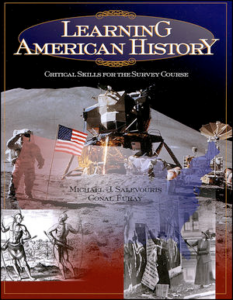
- What individuals had an important impact on the outcome?
- Were there any powerful ideas or belief-systems (ideologies) that were influential?
- Were there economic forces or interests that influenced the course of events?
- Were technological developments or constraints important?
- Was there a religious dimension to the situation?
- What role did organized groups play?
- Was there an institutional factor that must be taken into account?
- Was the physical environment a factor in the situation?
- What contingent factors were involved?
Example #5: Nikki Mandel and Bobbie Malone
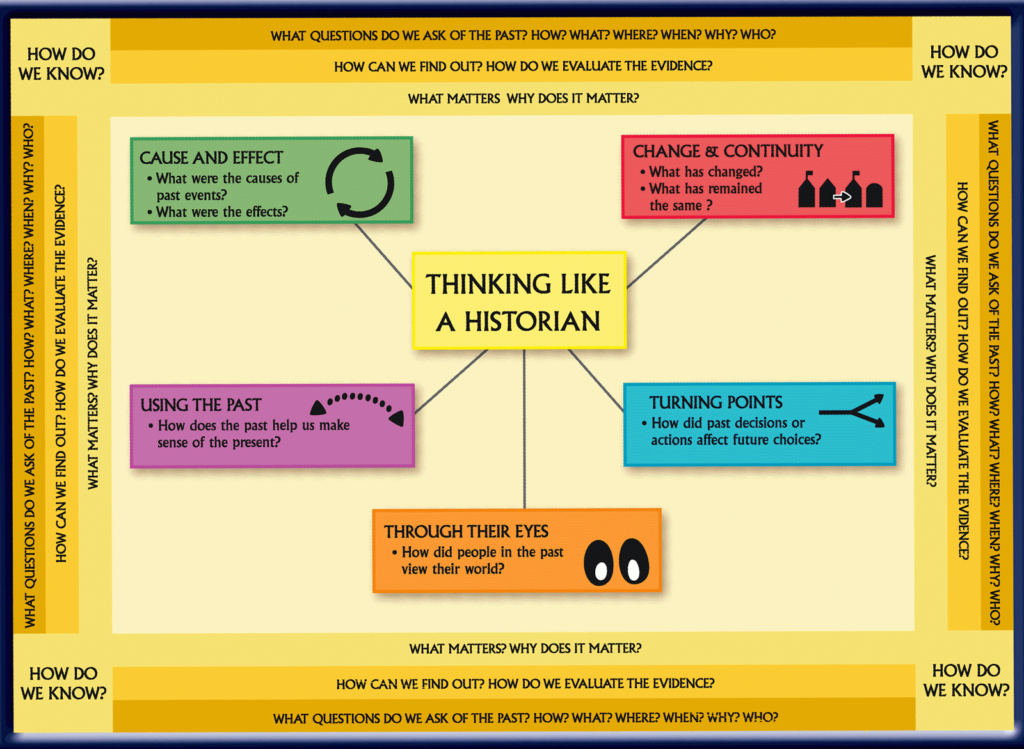
Example #6: John Bieter
- Gain a historical understanding. To be able to look at today through the eyes of the past.
- Identify historical interpretation. The three most important words in History are perspective, perspective, perspective. Events are distinctly experienced by each party involved.
- Build arguments. Historians frame problems and analyze evidence to create arguments. Arguments must include thesis statements that state assertions and answer how or why that is true.
- Differentiate between and work with primary and secondary sources through analyzing text, context and subtext of sources.
- Make arguments using cause and effect.
- Be aware of presentism; the judging of the past by the standards of today.
- Identify the necessity and changing nature of chronology and labeling time periods.
- Explain the relationship between the individual and the collective through the ‘forces of history’ – the effects of nationalism, class, race, gender, age, religion.
- Gain an understanding of historiography – that is the way different time periods have been interpreted over time. Furthermore, when we study a historical time period from another point in time we learn as much about that time period as the one being studied.
Example #7: Teacher’s Discovery
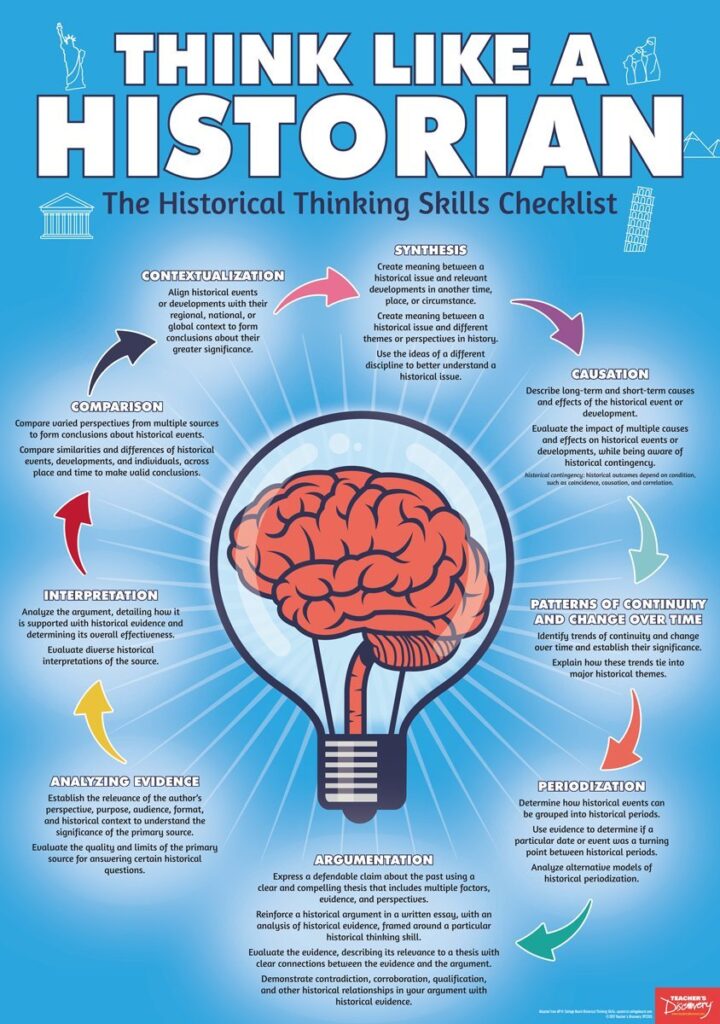
Other Suggested Sources
Andrews, Thomas, and Flannery Burke. “What Does It Mean to Think Historically?” Perspectives, Jan. 2007. http://www.historians.org/perspectives/issues/2007/0701/0701tea2.cfm
Gaddis, John Lewis. The Landscape of History. New York: Oxford University Press, 2004.
Jenkins, Keith. Re-Thinking History. New York: Routledge, 1991.
Lacy, Tim. “The Nine Cs of Historical Thinking.” Thinking Through History, May 3, 2013. https://thinkingthroughhistory.wordpress.com/2013/05/03/the-nine-cs-of-historical-thinking/.
Lowenthal, David. The Past Is a Foreign Country. New York: Cambridge University Press, 1985.
Pomeranz, Kenneth. “Recalling What We Do: Some Habits of Mind Historians Keep Hidden.” Perspectives on History, December 2013.
Wineburg, Sam. Historical Thinking and Other Unnatural Acts. Philadelphia: Temple University Press, 2001.